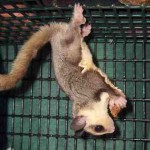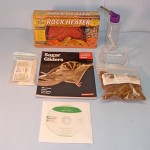What are the things I should do to generally keep my babyhealthy?
A baby Sugar Glider needs only a few things to stay healthy. Its biggest threats are getting too cold and getting dehydrated. To avoid those two problems, be sure to properly use the heat rock that comes with our starter kit, and be very observant of your glider for the first week or two to make sure it is drinking well.
You will pick up your glider often for bonding purposes. When you do, always do an examination of the baby. Is it toasty warm? Is it plump, and not dehydrated? Does it have good energy? (not lethargic). Does everything work? (like his legs, fingers, etc.) Is his poop fairly firm like pellets? (it is not uncommon for it to be loose while real young, but not to the point of runny like water) Is its coat nice and clean and fluffy? (this is a sign of good energy because he is grooming himself) Are his eyes nice and shiny and clear? If all of these things check out, your glider is, at that point at least, doing very well.
They also need to be fed properly. See Feeding Your Sugar Glider for in depth instructions on feeding.
My baby Sugar Glider has diarrhea.
Diarrhea in a baby Sugar Glider can be caused by at least two sources. The first possible cause is diet. Normally when you buy a baby Sugar Glider from a reputable breeder it will be 7 to 12 weeks out of the pouch. This is an infant Sugar Glider, especially on the lower end of that range. You cannot throw steak and potatoes to a human infant, you must start with formula and gradually add new foods as the infant grows and can handle it. The same i true of a baby Sugar Glider. The gut bacteria in a baby Sugar Glider, say 7-9 weeks, is not built up to handle a wide variety of foods yet. Our adult Sugar Gliders have apple and Glider Grub each evening along with other fruits and vegetables. When the mother weans her babies (makes them stop nursing) the babies are usually about 5 weeks out of the pouch. By the time they are weaned, they are eating the apple especially well and are picking up pieces of the Glider Grub and chewing on them. By the seventh week when they are taken from their parents, they are eating both quite well. We continue to give them the apple and Glider Grub for about two more weeks before we start adding other fruits and vegetables. If you find that they are not eating the Glider Grub well enough, you can soften and sweeten it with apple juice or better yet, the syrup from a can of peaches.
If you are feeding many types of foods to an infant Sugar Glider it can easily get temporary diarrhea from the overload. Acidic foods such as oranges and tomatoes are especially bad for this.
If you suspect that this is the source of the problem, cut back to a simple diet such as described above. In addition, make sure that the baby is always warm and is well hydrated. For a baby Sugar Glider, being too cold can cause all sorts of problems. They can get diarrhea, or get dehydrated. This happens because when a baby’s core temperature drops a degree or two, it cannot eat or drink. They get lethargic and do not have the ability to digest. This is serious, so always be sure to have the heat rock on and available for at least the first 3-4 months from the time you buy your gliders..
Sometimes just feeding it the syrup from peaches or fruit cocktail by a syringe will have a soothing effect on the stomach and solve simple loose stool, or light diarrhea.
If all is well in the diet area, but the Sugar Glider has diarrhea, it may have picked up a bacteria of some sort, usually from the stress of being too cold. If you suspect this to be the problem, you may need to take it to a vet in order to give it an antibiotic. They usually prescribe Panacur or Metronidazole, or both. Your vet will probably do a fecal exam and then determine the cause. He will prescribe the meds and tell you how to administer them. Normally the treatment will be for about 7 days. Be sure the baby has its heat rock and tee shirt in its cage for warmth. If the diarrhea was due to bacteria, this will usually turn the situation around. Often however, the diarrhea doesn’t go away until the glider is finished with the medication. Ask your vet if it is catching to your other glider. Usually it isn’t. If not leave your two gliders together. Being with another glider is very reassuring, and helpful while healing. Otherwise you now have one sick baby and two lonely ones.
Follow your vet’s instructions and be sure to keep the baby warm and well hydrated while treating it. Back to the Top!
My baby Sugar Glider is lethargic.
This is a very serious matter. Baby Sugar Gliders can quickly get dehydrated, if for whatever reason, they are not drinking, or have no opportunity to drink. In fact the two biggest threats to a baby Sugar Glider are being too cold and getting dehydrated.
When a baby gets dehydrated, hypoglycemia is soon to follow. With the dropping of the body fluids, the sugar level drops and the baby is in critical condition. With the drop in blood sugar the baby gets lethargic. In fact, if it is very dehydrated, it will be so weak that it cannot save itself. If you find your glider in this critical situation you must get it and keep it very warm (a cold baby Sugar Glider will not eat), and you must start feeding it fluids by hand every half hour until it is re-hydrated. Without your help it will almost certainly die.
 One sign of dehydration is the loss of plumpness in its body. In fact it will feel like skin and bones in extreme cases. When you lift the skin of the glider on his back, and it shows no sign of springing back into place, it is dehydrated. Other signs are diarrhea, lack of cleaning itself, and of course lethargy.
One sign of dehydration is the loss of plumpness in its body. In fact it will feel like skin and bones in extreme cases. When you lift the skin of the glider on his back, and it shows no sign of springing back into place, it is dehydrated. Other signs are diarrhea, lack of cleaning itself, and of course lethargy.
When faced with this situation we feed a mixture, at room temperature or a little warmer, of apple juice, Pedialyte, and a little honey. It can be fed with a small marsupial bottle and nipple (which most new owners don’t have), an eyedropper, or a syringe without the needle.
Warm a clean washcloth or other suitable soft cloth in a microwave until pleasantly warm (not too hot). Wrap the baby in it snuggly with only the face exposed. Remember, a cold Sugar Glider will not eat. Put the tip of your feeding instrument to the baby’s mouth. For the first few feedings it probably will not drink on its own. You must lift the upper lip and slowly and gently force a small amount into the mouth. Do not let the liquid go down the nostrils or you will aspirate its lungs. Slowly feed the baby all that it will take. Repeat this every half hour. If you start this process in time, by the third or fourth feeding the baby will be accepting more and giving you less trouble and resistance. This is a great sign that you will probably be successful. If everything is going well, soon it will be greedily licking the fluid from the syringe on its own as you feed it.
Do not expect it to take much on the first couple of feedings (maybe ½ to 1cc). When it is cooperating and licking on its own, it may drink 3 to 4 cc per feeding. Don’t stop these ½ hour feedings until it is well hydrated, has overcome the lethargy and is going to a similar mixture in a bowl on its own in its warm cage.
At this point you can start offering it a new formula. Take about 4 or 5 pellets of Glider Grub, 2 grapes with no seeds, a little honey, and about an ounce of water mixed with apple juice. Blend these together until it is a liquid. Then it can be fed by means of a syringe or in a lid if the baby will take it that way. At the same time keep offering a piece of sweet apple and the dry Glider Grub in the cage at all times until it is eating these as well.
When the baby starts cleaning itself you have reached a milestone. Even then, although the crisis is past, be very observant for a few days, making sure it keeps drinking appropriately, and maintains its energy. No one wants to go through this, or rather, have their glider baby go through it. However, if you do, there is nothing that will make you love your baby more than snatching it from certain death.
Note: If this is not working, or you cannot get any liquids in your Sugar Glider, get it to an exotic animal vet as quickly as possible. They have the ability to inject subcutaneous (under the skin) fluids. This may need to be done a few times before the baby will absorb these fluids and get re-hydrated. The fluids that they will inject will most probably be a mixture of saline and glucose. Back to the Top!
My baby Sugar Glider is aggressive.
Sugar Gliders are not aggressive animals. They are defensive animals. They are like a Blow Fish that puffs itself up in the face of danger in order to appear much bigger and tougher than it really is. This is not an aggressive move but rather a defensive move. Puffing up cannot hurt anyone or anything. It can only possibly scare off the real aggressor.
Sugar Gliders have only two defenses other than fleeing. One is a noise referred to as crabbing. This noise is very distinctive and is made only when the glider is afraid or feels threatened. It works too. I have seen policemen, with guns, vests, billy-clubs and mace on their hips, jump and back off at the unexpected sound of a 2 ounce baby Sugar Glider’s crabbing. I remember the first experience Chloe, our Maine Coon cat had with a Sugar Glider. Apparently the glider thought Chloe was getting a little too nosey or familiar with it, so it gave its crabbing defense. At that point it became a real life cartoon: Chloe could not grab the floor fast enough to escape the room. She jumped and hit the hardwood floor with all paws grabbing for traction. I honestly thought she was going to break her neck trying to escape the big bad Sugar Glider BABY. Soon however, all was well. She and the Sugar Gliders got along very well together after a few weeks of getting acquainted through the wire of the cage.

Sugar Gliders are not aggressive animals towards people.
So the point of all of this is, “Don’t be afraid of the crabbing noise”. It just means the glider is still not over its fear of you and you need to keep working with it. The noise itself cannot hurt you. Instead, confidently scoop it up in both hands and firmly turn it into a little ball in your firm fist. The more time it spends in your hands the sooner it will quit fearing you and quit crabbing.
The second defense a Sugar Glider has is its bite. An adult glider that has not been socialized can bite hard and certainly break the skin. However, a baby’s bite usually doesn’t break the skin. It is a strong pinch that can hurt, but not like a hamster or another type of rodent. Most hand raised babies don’t ever bite but some will. When they do bite it is important to realize it is only like a hard pinch and to not be afraid of it. If you are afraid of your glider, it will sense it and be more afraid of you. Learn to take the bite if necessary rather than back off or put it down. Gliders are a lot like kids, if you let them back you down, and get their way, you will have a spoiled Sugar Glider or kid on your hands. If you are holding them right, their fear of you goes away quite quickly. See Bonding with Your Sugar Glider for a more complete discussion of bonding.
A brand new baby Sugar Glider will be afraid of a new person’s scent. The best way to get them to trust that scent is to completely enclose it in a fist and then cover that fist with the flat of your other hand. The combination of being folded up and held firmly inside of the fist causes the glider to have security. The other hand over the fist causes more complete seclusion, and takes away all of the other distractions so that the baby has only one new thing to get used to: your new scent. When you do this you are giving the baby the same sensation of security that it had in mom’s pouch. If you hold the baby firmly enough and for several minutes you will usually feel the pounding heartbeat slow down to a normal slow beat. Then after a few minutes more, the glider will usually start vibrating. This is a purr. You cannot hear the glider purr, but you can feel it. It feels as if a little motor is running in its belly. After several more minutes, you will usually feel nothing. That is because the glider is sleeping in your warm hand. The more time spent in this state of trusting you enough to purr and sleep, the more the glider is being imprinted to the fact that you are the safest place to be. If you hold your glider a lot during the first two weeks of ownership, and carry it with you as well, as much as possible, it should consider you to be the center of its universe. I do not give a new baby any freedom for the first two weeks, and I carry them as much as possible. When they are not in my hands, or on my person in a pocket or pouch, I put them in the cage. There will be plenty of time for freedom after they are older and are totally bonded to you.
Holding your glider and massaging it for long sessions in your hands will cause the glider to calm down and start trusting you. The babies are raised in their mothers pouch. In there it is warm snug, and moving. It is  also a place of complete safety. Later in life, the safest place for a glider to be is in the den with its colony. Here they are out of harms way from predators. The whole colony will sleep piled upon one another. Again it is warm, snug, and moving, because as one glider wakes up and discovers it is on the top of the pile, it burrows under the others for warmth. When you hold your baby in your hands and give it lots of contact with your hands, massaging it firmly, but calmly and gently, you create the sense of security it felt in the pouch and in the colony. Again, it is warm, snug, and moving. We know of no quicker or better way to get the glider bonded to you than this method.
also a place of complete safety. Later in life, the safest place for a glider to be is in the den with its colony. Here they are out of harms way from predators. The whole colony will sleep piled upon one another. Again it is warm, snug, and moving, because as one glider wakes up and discovers it is on the top of the pile, it burrows under the others for warmth. When you hold your baby in your hands and give it lots of contact with your hands, massaging it firmly, but calmly and gently, you create the sense of security it felt in the pouch and in the colony. Again, it is warm, snug, and moving. We know of no quicker or better way to get the glider bonded to you than this method.
If the baby seems to be persistent in biting, it is not to be feared, but you also don’t want it to grow up with the bad habit of nipping you whenever it wants to. We have a method for stopping this bad behavior before it becomes a bad habit. Right after a bite, insert your index finger into and across the mouth. Make it deep enough that the baby’s mouth is extended open wide. This is uncomfortable for the baby. Leave the finger in the mouth with downward pressure on the lower jaw for 30 to 45 seconds. Then slowly remove the finger, giving the baby every opportunity to bite again. If it does, do not remove the finger, but rather reinsert and repeat the lesson for another 15 seconds. Do not completely remove the finger until he lets you remove it without resistance. That is the end of the lesson. Give the baby love and continue playing with it.
Every time it bites, repeat the above lesson. Soon it will associate biting you with the uncomfortable sensation that follows. Usually 4 or 5 lessons for a couple of days will stop this bad habit.
My Sugar Glider has an odor.
Cleanliness of the cage and the diet of the Sugar Glider are the two most important factors in the odor or lack thereof for your pet.
Sugar Gliders that have a lot of meat and or live food in their diets will have an odor. Likewise gliders given too many vitamins (especially liquid) will develop an odor. On the other hand, gliders that get their protein from a well-balanced dry soybean protein food, such as Glider Grub, and get plenty of fresh fruits and vegetables and only get meat or insects as an occasional treat, have virtually no offensive odor.
The cage of course must be kept clean. A good PVC coated cage can be pressure washed occasionally. As for the contents of the cage such as logs and branches, a good soaking in a mixture of one of the orange oil cleaners will usually remove any odors. Back to the Top!
I think that my male Sugar Glider has worms.
No, the problem is that he is becoming sexually mature. The penis of a Sugar Glider is like a red thread and is bifurcated (it splits at the end). Many people have called me thinking that their male Sugar Glider was worm infested, and they were coming out of him, and of course they were scared to death. Relax, this is normal, and sometimes it is out for extended periods of time as he is maturing.
 My Sugar Glider has an eye problem.
My Sugar Glider has an eye problem.
There are several reasons that can cause eye problems in Sugar Gliders. Overly fat Sugar Gliders do not breed well, but when they do breed they can produce babies that are born with fat deposits in their eyes. Since we haven’t had this problem I am not sure if they will outgrow this problem if given the proper diet. No reputable person would knowingly sell a baby in this condition. Check for this before buying. The eyes should be bright and alert.
A more common eye problem is caused by an abrasion or puncture, and subsequent infection. The symptom of an eye infection is the clouding of the eye. It looks gray and cloudy rather than black and sharp. Do not panic, this is a treatable condition. Do, however, address it immediately so that the animal doesn’t suffer needlessly and so that it doesn’t get any worse. You can take the animal to a vet, and he will most likely recommend an eye-drop such as Gentamicin. This is a sterile ophthalmic solution that can be dropped into the eye. If the infection is due to an abrasion, and caught early, only the damaged eye will be affected. It can however, spread to the other eye as well. Gentamicin cannot be purchased without a prescription.
A couple of home cures that are well worth trying are a triple antibiotic ointment (such as Neosporin) that can be bought without a prescription at a drug store, or Coloidal Silver which is a liquid that can be bought from most health food stores. The stages of this problem are first a swelling of the tissue under the affected eye. Secondly the eye will have mucus and will often be stuck shut after sleeping. Finally, the eyeball itself will cloud over. It will turn a light blue. This is a crystallization of the surface. The treatment is to force the eye open and clean any mucus out and then to either swipe a dab of the Neosporin directly on the surface of the eyeball itself, or
drop a drop of the Coloidal Silver directly into the eye. Treat the eye twice a day for as many days as it takes to bring the eye back to a clear black color.
If this doesn’t show signs of improvement in two days, or three at most, I would take it to a good vet for
the Gentamicin or whatever your vet recommends. Back to the Top!
My Sugar Glider has a boil or a cyst.
Sugar Gliders, like all animals, can get a puncture wound and develop an abscess. This is of course infection in a localized area. The puss is trying to fight off the infection. You may not want to treat this yourself if you are a bit squeamish or if the abscess is in a touchy area such as next to an eye or in the jaw area. It does need to be treated however, because this can be very painful for the glider. If you are not going to treat it right away, please take your glider to a vet asap.
The abscess must be drained. That means cutting it open slightly with a very sharp tool such as a scalpel or exacto knife (well sterilized of course), and squeezing the abscess fluids out of the pocket. Then you want to clean out the pocket as well as possible by flushing and or swabbing. Then the pocket must be treated with an antibiotic ointment. If I have to do this, I also administer the Coloidal Silver by means of a drop each day in a fresh water bottle. This draining may have to be repeated a time or two before it is well.
Gliders don’t take well to bandages of any kind, so just treat it and medicate it. If you don’t see progress, see your vet.

Sugar Gliders often eat while hanging upside down.
My Sugar Glider is limping or dragging a rear leg.
This could be a very serious problem. To find out, first pick up your glider and inspect it for any kind of injuries. Check its toes for ripped nails, and its feet and legs for any cut or damage of any kind.
If you don’t find an injury, take your glider to a good exotic animal vet asap. The problem is probably rear leg paralysis. When a Sugar Glider has a severe imbalance of its Calcium to Phosphorous ratio, or just extremely low levels of Calcium, they are in danger of having the dreaded Rear Leg Paralysis. With this condition the rear legs quit working and the tail as well. With quick care, some gliders do recover the use of the legs and tail, but not always. It will take a vet to get enough calcium in them however, because it will have to be done by means of a Calcium shot. Then you will want to be sure you correct the diet to eliminate the possibility of this happening again.
See Feeding Your Sugar Glider for a very good explanation of this problem. Normally Sugar Gliders on Glider Grub and Vita Glider do not have this problem. Back to the Top!

